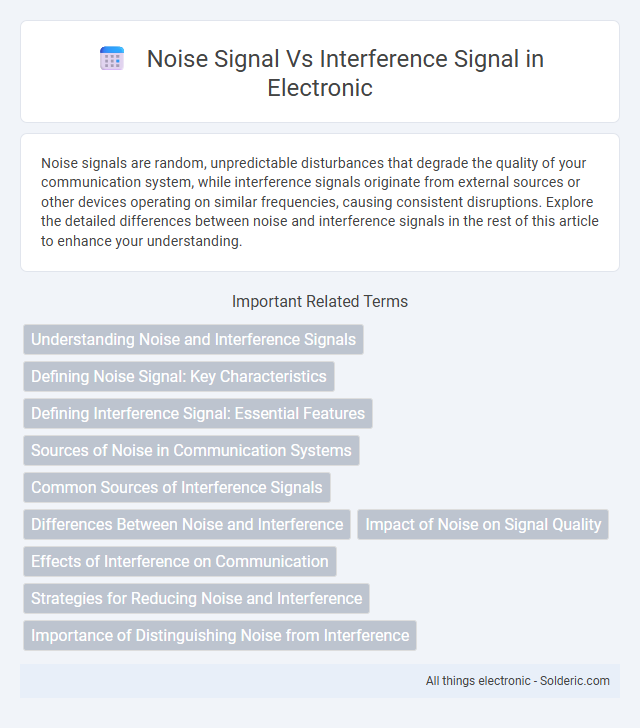Noise signals are random, unpredictable disturbances that degrade the quality of your communication system, while interference signals originate from external sources or other devices operating on similar frequencies, causing consistent disruptions. Explore the detailed differences between noise and interference signals in the rest of this article to enhance your understanding.
Comparison Table
| Aspect | Noise Signal | Interference Signal |
|---|---|---|
| Definition | Unwanted random electrical fluctuations | Unwanted external signals disrupting communication |
| Source | Thermal, atmospheric, and electronic components | Other transmitters, devices, or electromagnetic sources |
| Predictability | Random and broadband | Often structured and narrowband |
| Effect on Signal | Degrades signal quality by adding background fluctuations | Distorts or masks the original signal |
| Mitigation Techniques | Filtering, shielding, error correction | Frequency hopping, filtering, spatial separation |
Understanding Noise and Interference Signals
Noise signals are random, unwanted electrical fluctuations that degrade the quality of a communication system by masking the desired signal. Interference signals, on the other hand, originate from external sources such as other electronic devices or environmental factors, causing distortion or disruption in signal transmission. Differentiating between noise and interference is crucial for implementing effective filtering and signal processing techniques to improve overall system performance.
Defining Noise Signal: Key Characteristics
Noise signals are unwanted random electrical fluctuations that degrade the quality of communications and electronic systems by introducing unpredictable variations in amplitude, frequency, or phase. They are typically broadband, stochastic, and lack a fixed pattern, originating from sources such as thermal agitation, electromagnetic interference, or cosmic background radiation. Unlike deterministic interference signals, noise signals reduce signal-to-noise ratio (SNR) and complicate accurate data transmission or system performance.
Defining Interference Signal: Essential Features
Interference signals are unwanted electromagnetic waves that disrupt the desired communication signal, characterized by their origin from external sources such as other transmitters, electronic devices, or environmental factors. Unlike noise signals that are random and inherent to the system, interference signals often have identifiable patterns or frequencies that can be traced and mitigated. Understanding the essential features of interference signals enables you to design effective filters and shielding to improve signal clarity and system performance.
Sources of Noise in Communication Systems
Noise in communication systems originates from various sources, including thermal noise generated by electronic components, atmospheric noise caused by natural phenomena like lightning, and man-made noise from industrial machinery and electromagnetic interference. These noise signals degrade the quality of communication by introducing random fluctuations that obscure the original message. Understanding the sources of noise helps you implement effective techniques to mitigate their impact and improve signal clarity.
Common Sources of Interference Signals
Interference signals commonly originate from electromagnetic sources such as radio frequency transmissions, power lines, and switching devices, which disrupt the desired signal by introducing unwanted frequencies. Other typical sources include environmental factors like lightning, electrical motors, and fluorescent lighting that generate fluctuating electromagnetic fields. These interference signals degrade communication quality by overlapping or distorting the intended noise signal and are often differentiated through their periodic or transient characteristics.
Differences Between Noise and Interference
Noise signals consist of random, unpredictable fluctuations that originate from natural or electronic sources, degrading the quality of communication by adding unwanted background disturbances. Interference signals arise from external, identifiable sources such as overlapping transmissions or electromagnetic emissions that disrupt the intended signal's clarity. Understanding these differences enables you to implement targeted filtering and mitigation techniques to improve signal integrity and communication reliability.
Impact of Noise on Signal Quality
Noise signals degrade signal quality by introducing random fluctuations that mask the original information, reducing clarity and accuracy. This results in errors during data transmission, affecting the performance of communication systems and causing potential loss of important information. Your system's reliability depends on minimizing noise to maintain a clear and consistent signal reception.
Effects of Interference on Communication
Interference signals degrade communication quality by causing signal distortion, data loss, and increased error rates, leading to reduced system reliability. Unlike random noise, interference often results from specific sources like other transmitters or unauthorized devices, which can create persistent disruptions in signal clarity. Effective mitigation techniques such as filtering, shielding, and spectrum management are essential to minimize the adverse impact of interference on communication networks.
Strategies for Reducing Noise and Interference
Effective strategies for reducing noise and interference signals include implementing shielding techniques, such as using grounded metal enclosures to block electromagnetic interference (EMI), and employing twisted pair or coaxial cables to minimize signal degradation. Active filtering methods, like low-pass, high-pass, or notch filters, selectively eliminate unwanted frequency components, while error correction codes improve data integrity in noisy environments. Proper circuit design, including optimal grounding, spacing of signal lines, and the use of differential signaling, further enhances noise immunity and reduces interference impact on communication systems.
Importance of Distinguishing Noise from Interference
Distinguishing noise from interference is crucial for optimizing signal processing and communication system performance. Noise refers to random, unpredictable fluctuations that degrade the signal quality, while interference involves unwanted signals from external sources disrupting your desired transmission. Accurate identification enables effective mitigation strategies, improving data integrity and reducing error rates in complex electronic environments.
noise signal vs interference signal Infographic

 solderic.com
solderic.com